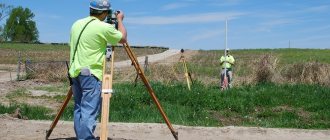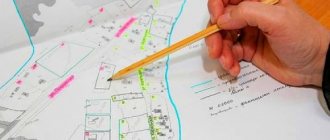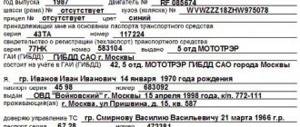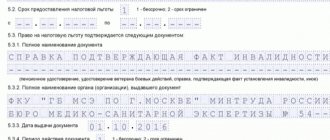Home / Real estate / Land / Land survey / Boundaries of the land / Changing the boundaries of the land
Back
Published: March 18, 2017
Reading time: 10 min
0
295
When performing various legal actions with a land plot (LP), sometimes it becomes necessary to divide it into 2 or more parts.
Since the land legislation of the Russian Federation accepts only an independent plot as an object of legal relations, in order to divide the land plot it is necessary to carry out its surveying and register its parts as independent land plots.
- Necessary conditions for delimiting the memory
- Stages of delimitation of land plots Carrying out the planning process for delimiting land plots
- Agreement on the division of land
- Assigning an address to new storage units
- Cadastral registration (CR) and registration of property rights (PS)
- Documents receiving
What is land consolidation
The procedure for merging plots is carried out on the basis of a written request from the owner. Both individuals and legal entities have the right to submit an application. The changes that have occurred do not affect the intended purpose of the land and the types of uses for which the permit was issued.
The legislation allows the merger of exclusively adjacent plots of land, regardless of the number of owners. The new plot can be either individual or shared ownership.
Among the reasons that provoked the need to merge areas are:
- increase in the value of the plot on the land market. As a result of the procedure, the owner receives a plot with a large area that can be sold at a profit. The price of one combined plot is significantly higher than two small plots, which together have a similar area;
- to simplify tax accounting. Organizations combine plots to facilitate tax payment procedures;
- if it is necessary to build a house or cottage for a large family. In order to prevent problems when obtaining a construction permit, owners of plots submit an application for their association in accordance with the norms of legal acts.
Note! The procedure must take into account the current requirements of land legislation.
Legal requirements
Regulatory acts provide for a number of requirements for plots that owners intend to combine. If at least one of them is violated, the procedure is considered illegal.
It is worth considering in detail the current system of requirements, which includes the following:
- It is allowed to combine only adjacent (those located nearby) areas; areas must undergo a land surveying procedure - determining the boundaries of the passage;
- the cadastral register must contain information about land surveying, otherwise the owners are required to carry out this procedure before submitting an application for amalgamation;
- the category must be the same for all plots, while no such restrictions are established regarding permission to use (due to the fact that the owner of the plot obtained as a result of the merger establishes a new type of use);
- the plots must belong to the same locality and be located within its boundaries;
- land plots that the owner has the right to use indefinitely or free of charge or as property that is inherited for life are allowed to be united only by one person who has the right of ownership;
- permission to use real estate is retained even after the merger of plots;
- as a result of the procedure, there should be no obstacles to the use and protection of the land, as well as obstacles that do not allow the placement of buildings or limit access to them;
- the combined areas should not wedge into the boundaries or violate their integrity;
- the procedure is carried out exclusively subject to compliance with the requirements of the law, which establishes size standards for combined plots.
Important! The area obtained as a result of the procedure for merging land plots must not exceed the maximum boundary limit specified in legal acts.
Writing off debts on land, property and transport taxes from the population in 2019.
How to register ownership of a land plot if there are no documents, read here.
What documents are needed to obtain land for a third child, read the link:
Step-by-step instructions for the merger procedure
The speed of the procedure depends on the complexity of the process (engineer visit, measurement work, remoteness of the land), as well as on their legal status. For example, if the territory belongs to a minor owner, you will definitely need permission from the guardianship authorities, which will also take several weeks to obtain.
In general, the registration procedure begins with the collection of documents. Then an engineer comes to the site, carries out measuring work and draws up a boundary plan for the combined (new) site
. And then you need to prepare documents for the new territory - this procedure is carried out at the local branch of Rosreestr.
Step 1. Collecting documents
These documents include:
agreements on the basis of which the plots became property (or the right of perpetual use);
- certificates of ownership;
- cadastral passports;
- passports of owners or copyright holders;
- other documents (for example, a notarized power of attorney for the owner’s representative, permission from the local Administration, if the land belongs to it, etc.).
The entire package of documents is submitted to Rosreestr. You can also contact a private company that has the appropriate license. In this case, the procedure will take only a few days
. In any case, the package of documents is accompanied by a statement, which is drawn up in any form.
Step 2. Drawing up a new boundary plan
After receiving the application, a specialist from Rosreestr or a private company goes to the area and conducts all the necessary research so that a new boundary plan for the land can be correctly drawn up. As a rule, the work takes 1-2 days. Its result is a finished document reflecting the layout of the new land plot resulting from the merger of the previous ones.
Step 3. Registration of property in Rosreestr
To do this, you must provide all the above documents to the Rosreestr office. All owners (or copyright holders) must come to Rosreestr in person.
. It is also possible to send your representatives, who can act in accordance with a notarized power of attorney.
Detailed video commentary on the merger procedure (using the example of SNT and individual housing construction)
It would seem that what could be simpler than combining two plots into one? In fact, the procedure involves collecting a package of documents and agreeing on all issues. Even if both plots belong to the same person, the procedure established by law must be followed.
Required documents
An owner who intends to merge land plots must provide the following documents:
- ID card (original and copies) along with TIN;
- a statement containing data on the boundaries of adjacent areas, a list of transferred documents and the reason for the merger.
To grant the right to consolidate the boundaries of plots, the owner is required to submit certificates for each plot or an extract from the register along with cadastral passports, as well as a notarized and properly executed consent to the merger.
Depending on the specific situation, officials of the relevant authority have the right, if necessary, to require the provision of additional documentation.
How to find out if you can change the VRI
First, you need to harmonize the types of permitted uses. That is, change the VRI in such a way that all memory devices have the same one. On the one hand, this is a fairly simple procedure. You can submit your application online. On the other hand, changing the permitted use has its own nuances. Find out how best to proceed in your case during a consultation with the Geomer Group engineering survey company.
To change the VRI you need to submit an application. This can be done by the owner or legal holder of the land plot. Along with the application, you must provide the following documents:
- Passport.
- Title documents for the land plot.
The local administration requests most documents as part of interdepartmental cooperation. Therefore, the applicant has the right not to provide them. This category includes extracts from registers, GPZU, etc. You will receive a response to your application within 15 working days. In the event that you change the type of permitted use to build a capital facility, the review period will be 45 days.
If the administration makes a positive decision, it submits documents to Rosreestr. Based on the decision to change the permitted use, changes are made to the Unified State Register. You receive a statement with new characteristics of the site.
The administration may refuse to change the type of use. If you believe that you were refused unlawfully, you can appeal the decision through the court. The VRI cannot always be changed. To assess the likelihood of a positive outcome of the case, seek advice from our expert.
After the type of permitted use has been changed and all changes have been made to the Unified State Register, you can begin the procedure for merging land plots.
We recommend that you find out in advance the prospects for changing the type of permitted use. This can be done in different ways:
- Study the PZZ and GPZU. Urban planning documents indicate all possible types of permitted use for land plots. You can order an extract and find out which VRI are installed for your memory.
- Town planning regulations for the territorial zone. Here you can also find information about all VRI - main, conditionally permitted, auxiliary. Town planning regulations are part of the PZZ. You can find them on the official website of administrative education.
- Select the type of use that will best suit the purpose of the change. Each VRI group has different use cases. From this list you need to choose the appropriate option.
If you do not want to search on your own, you can contact for help. During a free consultation, our specialist will review your situation and tell you what the risk of being rejected is.
Where to contact
Personnel records, together with registration of ownership of a plot obtained as a result of consolidation, can be carried out in the following ways:
- by submitting an application to the territorial department of state registration;
- by contacting the MFC;
- through the use of the State Services portal, on which a special form is filled out.
Regardless of the chosen option, the applicant undertakes to provide the established package of documentation.
Watch the video. Consolidation of land plots:
Submitting an application
The application procedure depends on the number of owners. In a situation where land plots are individually owned, first contact the local administration. After the approval procedure, the documents are submitted to the cadastral chamber.
Remember! If the plots have several owners, then it is necessary to obtain the consent of each of them for consolidation, which is formalized in the form of a collective agreement.
The document is submitted to the cadastral chamber for subsequent determination of boundaries.
The application is drawn up in writing and, in addition to the personal data of the owner, contains the following data:
- name of the authorized body;
- cadastral numbers of land plots that are being merged;
- information about the category and purpose of sites, as well as the presence of restrictions;
- list of provided documentation.
Areas with encumbrances
Is it permissible by law to combine plots of land if one of the plots has any encumbrance? If a plot of land is, for example, pledged or leased, you will additionally need to obtain consent to the procedure from the pledge holder (tenant, land user). It should also be taken into account that when merging plots, one of which is pledged, the right of pledge will be extended to the entire newly formed land plot, unless other conditions are established by agreement with the pledgee.
Carrying out land surveying
Based on the application, the cadastral engineer, who has received the appropriate certification, carries out land surveying. According to the law, the plan drawn up as a result of boundary work serves as the basis for registering ownership rights to the object and cadastral registration.
The document contains data about the newly formed site: area, location and boundaries.
The characteristics of the plan must coincide with the information in the state register, otherwise the object will not be registered in the cadastral register.
To reliably record data about the site obtained as a result of consolidation, one must not forget about the following important nuances:
- the combined plot receives a new cadastral number with the simultaneous cancellation of the old ones that were previously assigned to each plot before the procedure;
- the initial information about the objects is excluded from the Rosreestr database and the characteristics of the new site are entered;
- An extract from the Unified State Register provided to the owners serves as confirmation that the above actions have been carried out.
ATTENTION! Look at the completed sample application for land surveying:
Legal disputes arising during land consolidation
The most common problem when merging land plots is a negative response in the state registration of the right to the created plot. In this case, it is necessary to request a written refusal from the regional office of Rosreestr. Next, you need to study its reasons. If they are truly justified and there is an error in the merger, it is necessary to eliminate the shortcomings and resubmit the application. However, it happens that Rosreestr unreasonably refuses registration. In this case, there are two solutions:
- appeal the action to a higher authority (a complaint against the decision of the regional Rosreestr department is submitted to the federal body of state registration, cadastre and cartography);
- appeal the decision in court by filing a claim within the framework of administrative proceedings.
Problems often arise when concluding an agreement with land owners on amalgamation. There is no legal requirement for notarization of such an agreement. However, many government agencies that you have to contact require a certified agreement. In this case, their refusals will have to be appealed, wasting money and time. Therefore, many lawyers recommend notarizing the agreement.
Judicial practice in resolving disputes
Let us turn to judicial practice on resolving disputes arising during the consolidation of land plots.
The Frunzensky District Court of Yaroslavl in the first instance made a decision on the claim of three citizens. They appealed the decision of the local administration. These citizens had a house in common shared ownership. In fact, the house was located on three plots of land at once. The building was surrounded by a fence, and therefore natural boundaries of the site were established. The administration rejected the request to consolidate the lands, citing the fact that it was impossible to identify all their owners.
The panel of judges, having studied the arguments of the parties, came to the conclusion that the consent of the owner of the house, who was deregistered and has not lived there for a long time, is not required. Therefore, by its decision, the court overturned the refusal of the local administration and ordered the unification of the lands.
As another example, let us cite the decision of the Nurimanovsky District Court. The following legal situation arose: the local administration transferred the land plot to the plaintiff free of charge. It later turned out that this land was divided into two independent sections. The plaintiff contacted the administration to merge the land plots free of charge, since they were divided without his knowledge and consent. The administration of the Moscow Region agreed with the citizen’s arguments and instructed the cadastral center to carry out work on the unification. This body refused to allow the plaintiff to carry out the work free of charge, after which the latter went to court.
The court, after listening to the arguments of the parties, came to the conclusion that the consolidation of land plots should be carried out at the expense of the plaintiff, however, explaining to him the right to file a claim with the local administration to recover the amounts paid, since this situation occurred precisely as a result of their mistake.
The Solnechnogorsk City Court of the Moscow Region in the first instance considered the case on establishing the area of the united land plot. Due to an error by the cadastral chamber, it is impossible to register the plot and assign it an address, as well as determine its boundaries. The court, having considered the arguments of the parties, decided that the cadastral chamber was obliged to eliminate the violations it had committed and determine the area of the land. The court decision is the basis for registering the land plot and reimbursing the plaintiff for the costs and expenses incurred.
To summarize, it should be noted that when merging land plots, it is necessary to strictly follow all the requirements of the law and protect your rights in case of their violation. The courts, in most cases, take the side of the plaintiffs only when state and local government bodies have committed obvious errors and violations.
Similar articles:
- Re-registration of a dacha plot The procedure for re-registering a dacha to another person How to re-register a dacha to another person depends on the state of the documents...
- Changing the territorial zone of a land plot The procedure for changing the territorial zone of a land plot Territorial zones - elements of the PZZ of a settlement Assignment of land plots to...
- Seizure of an unregistered land plot What is unauthorized seizure of land To understand the terminology, know that unauthorized seizure of a land plot is called unauthorized...
- Registration of a garden plot as a property What is a plot from SNT? A garden plot is a land plot belonging to the agricultural category of land...
Registration procedure
A new property is subject to mandatory registration with Rosreestr.
To consolidate adjacent land plots, the following is provided:
- documents that establish rights to plots (certificate or extract from the Unified State Register of Real Estate);
- permission from the landlord for consolidation, which is submitted along with the lease agreement;
- boundary plan;
- passports of plot owners;
- application in the established form intended for registration and implementation of the registration procedure;
- a financial document that confirms the payment of fees for government services.
This list provides for the provision of originals only.
The order of combining two into one: procedure and stages
IMPORTANT! You need to request a cadastral plan of the site from the Unified State Register of Real Estate (USRN). This information is required to study the condition of the adjacent boundaries of the area
. If errors are identified among the results of the last survey, you need to submit an application to correct them.
To combine any number of adjacent plots into one, the owner submits the specified documentation. List of documents for merging plots:
- This is a document proving the identity of the submitter (you can take a photocopy).
- photocopies of certificates for adjacent plots;
- cadastral certificate for the plot;
- notarized permission to form a single plot.
To issue a ruling, additional information may be required, but most often a standard package of documents is sufficient.
Sample application
To obtain permission, the owner must fill out a sample application for the consolidation of land plots. This document must contain information about the boundaries of the original territories, a list of attached papers, as well as the reason for the unification.
The document can be drawn up either on a standardized form or in free form, but it is strongly recommended that the document be drawn up in printed format.
With different permitted uses
When connecting land plots, the type of permission to use plays an important role. If it is very different, the formation procedure will not be possible
. Agricultural and individual housing construction types are compatible, but industrial and forest plantations are not compatible.
In what cases is it not allowed to combine adjacent land plots:
- these territories belong to one individual or legal entity by right of hereditary ownership;
- one of the sites belongs to the owner by the right of lifelong inheritable heritage, and the second - by the right of perpetual use;
- All plots belong to the owner on a perpetual use basis.
IMPORTANT! To obtain the right to connect areas with different types of permitted use, you need to change the category of one or more of them, with the permission of the owner.
A package of documents is provided for this:
- tenant's passport;
- connection request;
- lease contract;
- cadastral certificate;
- documents for construction.
For individual housing construction, the list is supplemented by plans for the territory and building, as well as a written agreement from the owners and neighbors. After receiving permission, you need to submit documents to Rosreestr to edit data in the Unified State Register and property documents.
When the type of permitted use is changed, the owner submits the usual package of documents to form a common territory.
Areas with encumbrances
Encumbrances on a land plot are restrictions that do not allow a full range of actions to be carried out with it.
Types of encumbrances:
- easement;
- mortgage;
- long-term;
- concession;
- arrest based on a court decision;
- trust management.
Before merging sites, problems with encumbrances must be resolved, otherwise in some cases it will be impossible to combine two sites, and in some cases restrictions will apply to them.
Leased plot
If the land sites are leased, then only the lessor must deal with the connection, and the rules for combining remain the same; at the discretion of the parties, at the end of the lease agreement, the sites can be divided again.










